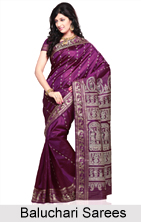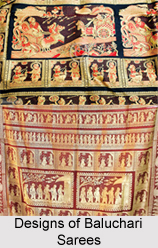 Baluchari sarees are the creation of the East Indian artisans who give much effort to create this traditional saree. These sarees are defined by the pictorial details that are created with great artistry in the sarees. Sometimes the borders of Baluchari sarees are embellished with scenes from the "Ramayana". East India has got an added mark for creating Baluchari sarees with the availability of artisans and fabrics. The specialty of the sarees of east India rests on the fabric, weaving technique and the traditional designs. The exemplary Baluchari sarees are created in Bankura, Burdwan and Murshidabad, though the contemporary style of Baluchari sarees are created keeping in mind the royal touch and unique appeal of the sarees.
Baluchari sarees are the creation of the East Indian artisans who give much effort to create this traditional saree. These sarees are defined by the pictorial details that are created with great artistry in the sarees. Sometimes the borders of Baluchari sarees are embellished with scenes from the "Ramayana". East India has got an added mark for creating Baluchari sarees with the availability of artisans and fabrics. The specialty of the sarees of east India rests on the fabric, weaving technique and the traditional designs. The exemplary Baluchari sarees are created in Bankura, Burdwan and Murshidabad, though the contemporary style of Baluchari sarees are created keeping in mind the royal touch and unique appeal of the sarees.
Origin of Baluchari Sarees
Murshidabad in West Bengal is the abode of Baluchari silk sarees and it has also been said that the conception of Baluchari saree was derived from Jamdani sarees of Dhaka.
Etymology of Baluchari Sarees
The name, `Baluchari` is the derivative of the name of a small village called Baluchara, located in Murshidabad.
History of Baluchari Sarees
Baluchari Saree has come into tradition before 200 years. The history of the Baluchari sarees portrays that the patterns and motifs that were used in earlier times, shows a strong inspiration of Mughal aesthetic values. At that time, the sarees were specially worn by the elite class due to its high quality. In the 18th century, the sarees of east India received the royal patronage thus developing the weaving tradition of Bengal as a whole.
Designs and Motifs of Baluchari Sarees
The Baluchari sarees are often reckoned with the patterning of sun, moon, stars, mythical scenes and motifs of natural objects with repeating pictorial themes in the border of the saree.  Extensive use of dark red, yellow, green, purple, chocolate, cream, white and blue colour since decades have made the saree the choice of all age group. The fields of the saree are embellished with small butis and the edges are designed with beautiful floral designs. The endpiece of the sarees are the main attraction as they manifest narrative motifs.
Extensive use of dark red, yellow, green, purple, chocolate, cream, white and blue colour since decades have made the saree the choice of all age group. The fields of the saree are embellished with small butis and the edges are designed with beautiful floral designs. The endpiece of the sarees are the main attraction as they manifest narrative motifs.
Baluchari sarees possess a silk base with silk brocaded designs. It has remained one of the trends to create light contrast with a rich composition of the "Baluchar Bootidars". The created patterns are done with contrast yarns that harmonize with the base of the fabric. The most popular colours used are red, blue, yellow, green and scarlet. The Baluchari sarees have large floral motifs interspersed with flowering shrubs. Traditionally the Muslim community was reckoned as an excellent group of artisans who produced these Baluchari sarees with figured patterns. Most of the patterns were the reverberations of "court scenes", "horse with a rider", "women smoking hookah" including the "Kalka design" or the "cone motif with floral borders". As the nature and myths have played prominent part in the creation of the sarees, the architectural designs have also a great influence in the sarees of east India as in Baluchari sarees. The artisans of this district derive ample influence from the intricately carved terracotta temples of Bishnupur.





















